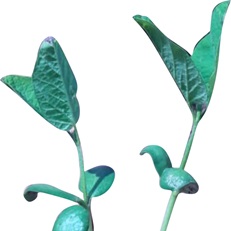
Morphological characteristics and yield performance of mutant soybean [Glycine max (L.) Merr.] M6 genotypes in Jatinangor, Sumedang, West Java
Andrew Yoel(1*), Meddy Rachmadi(2)
(1) Department of Agronomy, Faculty of Agriculture Universitas Padjadjaran Jl. Raya Bandung Sumedang KM 21, Jatinangor 45363
(2) Department of Agronomy, Faculty of Agriculture Universitas Padjadjaran Jl. Raya Bandung Sumedang KM 21, Jatinangor 45363
(*) Corresponding Author
Abstract
Current breeding efforts in soybean largely focus on identifying genotypes with high seed yield and large seed size. Our study applied a mutation using 250 Gy Gamma-Ray Irradiation to soybean cv. Anjasari. The variability in the M1 generation was identified, and the planting was continued to M2 M3, M4, M5 until M6 generation. The objectives of this research were to evaluate mutant lines exhibiting a good performance in yield and morphological characteristics that can support the yield component in M6 generation. This research was conducted from January 2019 to May 2019 at Ciparanje Experiment Station, Faculty of Agriculture, Universitas Padjadjaran, Jatinangor, West Java. The experiment was arranged in a Randomized Completely Block Design with fifteen mutant soybean genotypes as treatments with two replications within each treatment. The results showed several genotypes produced higher yield and better agro-morphological characteristics. The genotypes MR-33, MR-4A, and MR-2A showed significantly higher number of total pods per plant. Meanwhile, the genotypes MR-35A, MR-37, MR-23, MR-36A, MR-3A, MR-29A MR-34A, MR-4A, MR-17, and MR-5A showed a higher value in weight of 100 seeds. The highest yield was observed in MR-29A and MR-23, which then will be used as the genotypes for multilocation test for stability.
Keywords
Full Text:
PDFReferences
Alan, O. and H. Geren. 2007. Evaluation of heritability and correlation for seed yield and yield components in Faba Bean (Vicia faba L.). Journal of Agronomy, 6: 484–487.
Ali, I.M., R. Nulit, M.H. Ibrahim, and M.K. Uddin. 2018. Effect of delay harvest on seed quality and germination of three varieties of soybean (Glycine max) seed. Plant Archives, 18: 1961–1966.
Badan Pusat Statistik. 2018. Impor kedelai menurut negara asal utama. https://www.bps.go.id/statictable/2019/02/14/2015/impor-kedelai-menurut-negara-asal-utama-2010-2017.html
Banaszkiewicz, T. 2012. Nutritional value of soybean meal. p. 1-21, In: Hany El-Shemy (ed.). Soybean and nutrition. Ritjeka: InTech
Burris, J. S., O. T. Edje, and A.H. Wahab, 1973. Effects of seed size on seedling performance in soybeans: seedling growth and photosynthesis and field performance. Crop Science, 13: 207-210.
Dharmasiri, L. M. 2012. Measuring agricultural productivity using the average productivity index (API). Sri Lanka Journal of Advanced Social Studies, 1: 25-44.
Egli, D. B. 2013. The relationship between the number of nodes and pods in soybean communities. Crop Science, 53: 1668–1676.
Faot, M.M., S. Zubaidah, and H. Kuswantoro. 2019. Genetic correlation and path analysis of agronomical traits of soybean ( Glycine max ) lines infected by CpMMV. Biodiversitas, 20: 1496–1503.
Hu, M. and P. Wiatrak. 2012. Effect of planting date on soybean growth, yield, and grain quality: Review. Agronomy Journal, 104: 785–790.
Jelihovschi, J., C. Faria and I.B. Allaman. 2014. ScottKnott: A package for performing the scott-knott clustering algorithm in R. TEMA (São Carlos), 15: 3-17.
Krisnawati, A. and M.M. Adie. 2015. Selection of soybean genotypes by seed size and its prospects for industrial raw material in Indonesia. Procedia Food Science, 3: 355–363.
Laskar, R. A. and S. Khan. 2017. Assessment on induced genetic variability and divergence in the mutagenized lentil populations of microsperma and macrosperma cultivars developed using physical and chemical mutagenesis. PLoS ONE, 12: 1–18.
Liu, D., Y. Yan, Y. Fujita, and D. Xu. 2018. Identification and validation of QTLs for 100-seed weight using chromosome segment substitution lines in soybean. Breeding Science, 68: 442–448.
Madanzi, T., C. Chiduza, S.J.R. Kageler, and T. Muziri. 2012. Effects of different plant populations on yield of different soybean (Glycine max (L.) Merrill) varieties in a smallholder sector of Zimbabwe. Journal of Agronomy, 11: 9-16.
O’Keefe, S., L. Bianchi and J. Sharman. 2015. Soybean nutrition. SM Journal of Nutrition and Metabolism, 1: 1006.
Oz, M., A. Karasu, A.T. Goksoy, and Z.M. Turan. 2009. Interrelationships of agronomical characteristics in soybean (Glycine max) grown in different environments. International Journal of Agriculture and Biology, 11: 85–88.
Sudaryanto, T. and D.K. S. Swastika. 2007. Ekonomi kedelai di Indonesia. Kedelai – Teknik produksi dan pengembangan. https://balitkabi.litbang.pertanian.go.id/wp-content/uploads/2016/03/dele_1.tah lim-1.pdf
United States Department of Agriculture. 2019. World agricultural production. Circular series May 2019. https://apps.fas.usda.gov/psdonline/circulars/production.pdf
Vu, T.T.H., T.T.C. Le, D.H. Vu, T.T. Nguyen and T. Ngoc. 2019. Correlations and path coefficients for yield related traits in soybean progenies. Asian Journal of Crop Science, 11: 32–39.
Xue, H., K. Zhang, W. Li, Z. Qi, Y. Fang, X. Li, Y. Wang, J. Song, Wen-Xia, Li, H. Ning. 2019. Mapping developmental QTL for plant height in soybean [Glycine max (L.) Merr.] using a four-way recombinant inbred line population. PLoS ONE, 14: 1–15.
Yuliasti and Reflinur. 2017. Field performance of five soybean mutants under drought stress conditions and molecular analysis using SSR markers. Atom Indonesia, 43: 103–109.
Zhang, Y., P. Teng, M. Aono, Y. Shimizu, F. Hosoi, and K. Omasa. 2018. 3D monitoring for plant growth parameters in field with a single camerby multi-view approach. Journal of Agricultural Meteorology, 74: 129–139.
Article Metrics
Refbacks
- There are currently no refbacks.
Ilmu Pertanian (Agricultural Science) ISSN 0126-4214 (print), ISSN 2527-7162 (online) is published by Faculty of Agriculture Universitas Gadjah Mada collaboration with Perhimpunan Sarjana Pertanian Indonesia (PISPI) and licensed under a Creative Commons Attribution-ShareAlike 4.0 International License.












_2025_-_kecil_.png)
_2024_kecil_2.png)
